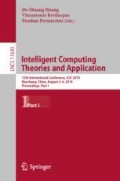Abstract
Dislocation theory of material science is introduced into the level set method. The curve evolution of level set method is viewed as the slipping of edge dislocation, and the curve evolution is driven by the dislocation configuration force which is derived based on the dislocation dynamics mechanism. In the image segmentation, the proposed algorithm can effectively avoid the phenomenon that level set function stop evolution because of the abnormal image gradient, and the phenomenon of boundary leakage because of the smaller image gradient. Experimental results show that the proposed algorithm has better segmentation performance for images with weak boundaries.
Access this chapter
Tax calculation will be finalised at checkout
Purchases are for personal use only
References
Jiang, H., Zhang, G., Wang, H., Bao, H.: Spatio-temporal video segmentation of static scenes and its applications. IEEE Trans. Multimedia 17(1), 3–15 (2015)
Koo, H.I.: Segmentation and rectification of pictures in the camera-captured images of printed documents. IEEE Trans. Multimedia 15(3), 647–660 (2013)
Cheng, M., Mitra, N.J., Huang, X., Torr, P.H., Hu, S.: Global contrast based salient region detection. IEEE Trans. Pattern Anal. Mach. Intell. 37(3), 569–582 (2015)
Thomas, B., Joachim, W.: Level set segmentation with multiple regions. IEEE Trans. Image Process. 15(10), 3213–3218 (2006)
Li, C., Huang, R., Ding, Z., Gatenby, J.C., Metaxas, D., Gore, J.: A level set method for image segmentation in the presence of intensity inhomogeneities with application to mri. IEEE Trans. Image Process. 20(7), 2007–2016 (2011)
Li, C., Xu, C., Gui, C., Fox, M.D.: Distance regularized level set evolution and its application to image segmentation. IEEE Trans. Image Process. 19(12), 3243–3254 (2010)
Luo, Y., Chung, A.C.: Nonrigid image registration with crystal dislocation energy. IEEE Trans. Image Process. 22(1), 229–243 (2013)
Caselles, V., Kimmel, R., Sapiro, G.: Geodesic active contours. Int. J. Comput. Vision 22(1), 61–79 (1997)
Chan, T.F., Vese, L., et al.: Active contours without edges. IEEE Trans. Image Process. 10(2), 266–277 (2001)
Bernard, O., Friboulet, D., Thevenaz, P., Unser, M.: Variational b-spline level-set: a linear filtering approach for fast deformable model evolution. IEEE Trans. Image Process. 18(6), 1179–1191 (2009)
Shi, Y., Karl, W.C.: A real-time algorithm for the approximation of level-set-based curve evolution. IEEE Trans. Image Process. 17(5), 645–656 (2008)
Zhang, F., Zhang, X.: Distance regularized level set image segmentation algorithm by means of dislocation theory. Acta Automatica Sinica 44(5), 178–187 (2018)
Wang, X.F., Min, H., Zou, L., Zhang, Y.G.: A novel level set method for image segmentation by incorporating local statistical analysis and global similarity measurement. Pattern Recogn. 48(1), 189–204 (2015)
Acknowledgment
This research was supported by the Natural Science Foundation of China (No. 61771006 and No. U1504621), the Natural Science Foundation of Henan Province (No. 162300410032).
Author information
Authors and Affiliations
Corresponding author
Editor information
Editors and Affiliations
Rights and permissions
Copyright information
© 2019 Springer Nature Switzerland AG
About this paper
Cite this paper
Zhang, F., Zhang, B., Zhang, X. (2019). Dislocation Theory Based Level Set Image Segmentation. In: Huang, DS., Bevilacqua, V., Premaratne, P. (eds) Intelligent Computing Theories and Application. ICIC 2019. Lecture Notes in Computer Science(), vol 11643. Springer, Cham. https://doi.org/10.1007/978-3-030-26763-6_21
Download citation
DOI: https://doi.org/10.1007/978-3-030-26763-6_21
Published:
Publisher Name: Springer, Cham
Print ISBN: 978-3-030-26762-9
Online ISBN: 978-3-030-26763-6
eBook Packages: Computer ScienceComputer Science (R0)

